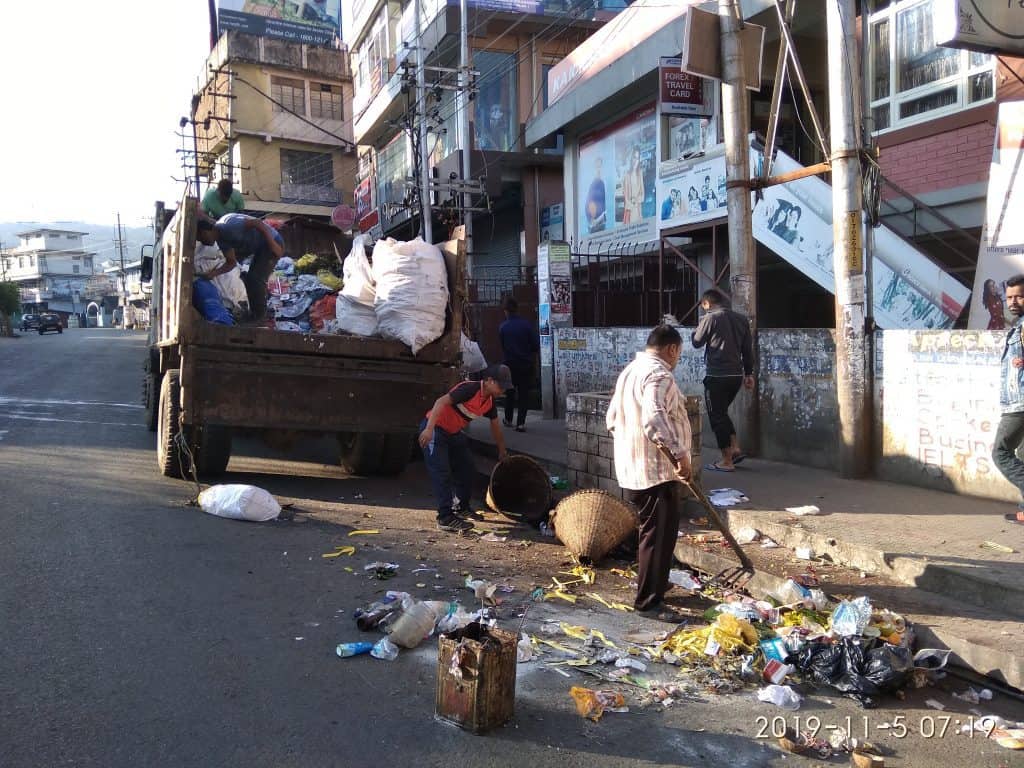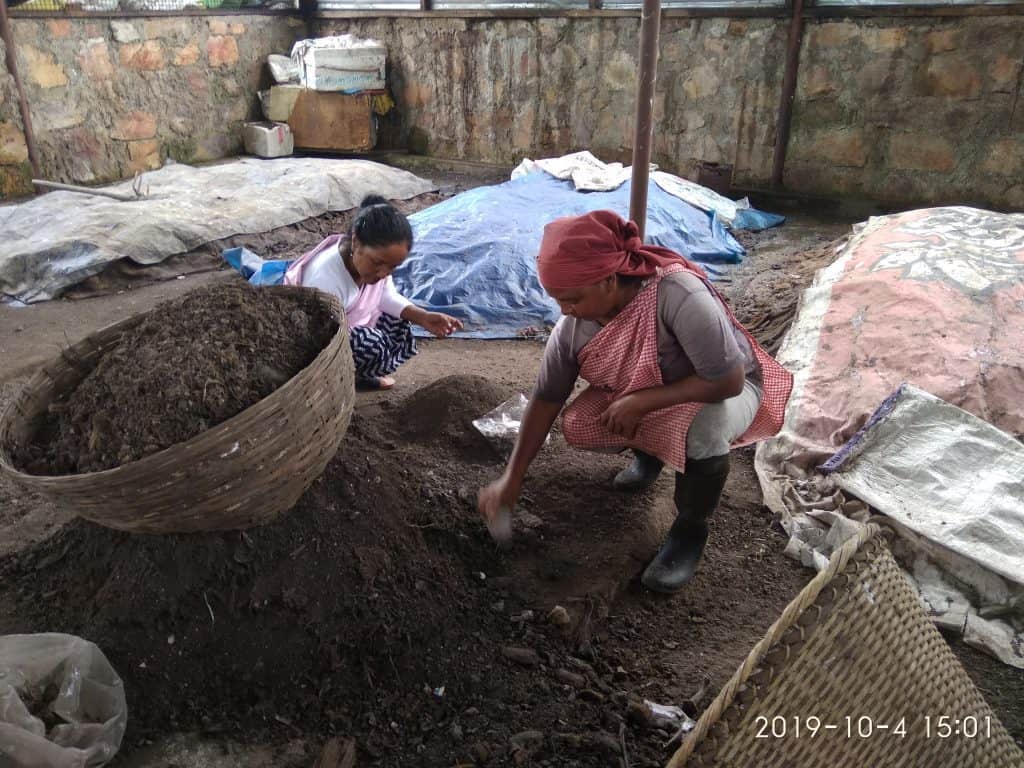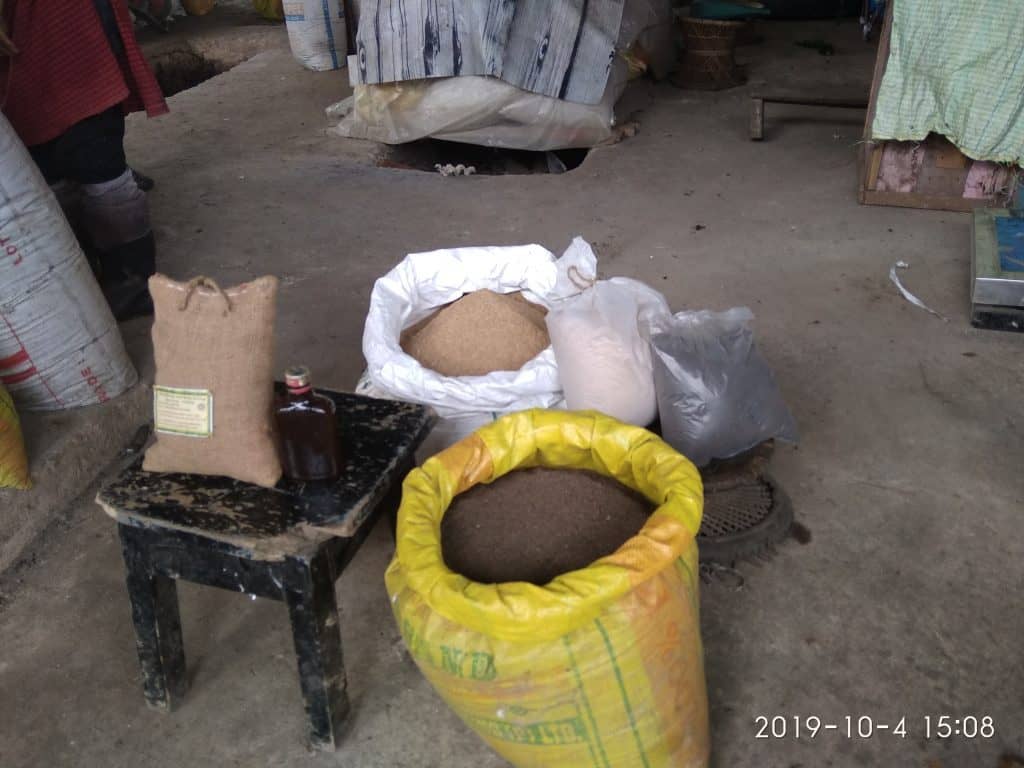The big money plans for waste treatment remain on paper. But a small community-oriented scheme for waste treatment, which was a small part of that big plan, is showing promise. Trash to cash is not just a cliché for this diverse group of poor women in Shillong. Earning a livelihood as waste pickers earlier, these women have banded together as a self-help group to sift and convert bio degradable waste dumped at a nearby landfill into saleable compost.
Shillong, as most of Meghalaya today, faces an ugly garbage crisis that threatens to wipe out her claim as the queen of hill stations. None of Meghalaya’s towns have a proper waste collection and disposable system in place. Shillong, which set up one of the first municipalities in the country, notified as a Station in 1878 then, is today groaning under rubbish thrown around the capital every which way. Set in the vale of hill ranges of the Shillong Peak, the town is an agglomeration of the Shillong Municipal Board (SMB), 10 Census towns surrounding it and the Shillong Cantonment Board (SCB), covering a population of around 4.16 lakh spread across 25.04 sq. kms as per the Smart City project documents of the state government.
The solid waste in the SMB area of 10.36 sq. kms is collected and disposed by municipal workers, while the SCB manages waste disposal on its own. The 10 census towns however, are governed by traditional institutions called Dorbars, basically a council of local residents. Each Dorbar has an executive committee and a headman chosen by the general residents of the locality every two or three years depending on the locality. All dorbars fall under the district council, which in the case of Shillong come under the Khasi Hills Autonomous District Council. Besides other responsibilities, the Dorbars are supposed to manage the waste in their own localities.
Landfills all over
But all the waste collected in whatever haphazard way from these places is finally dumped in the only designated landfill site called Marten, in the outskirts of Shillong. The state government has been trying in vain to set up a waste recycling plant at Marten for the past two decades. The reality however is that landfills have been created in the gorges, where bands of waste pickers sift the garbage for items to sell to trash traders. The stink from the garbage in Marten, 8 kms from Shillong city limits, pollutes the air for miles around.

Shillong Municipal workers clear garbage from the streets of Laitumkhrah, a Shillong market which will be dumped in Marten. Pic: Linda Chhakchhuak
Shillong, at an altitude of 1,520 metres (4,990 feet) above sea level, stretches for about 6 km on an elevated tract. The Umiam gorge bounds it on the northwest. The main rivers that drain the city are the Umshyrpi and the Wahumkhra rivers with its many tributaries which merge with the Umiam River finally flowing into the Umiam Dam or Barapani lake, the main source of electricity in the state. But over the years, every flowing stream has been turned into drains as people dump their waste into these once sparkling streams, or have built mansions and other constructions over them. Not surprisingly, in the first ever survey done by the Union Ministry of Tourism on Shillong’s cleanliness from a tourism point of view ranked it the ‘dirtiest” city in 2015. The Swachh Survekshan 2019 survey ranked Shillong at 394 out of 425 cities in cleanliness.
All efforts to manage city waste have failed so far. The most recent one was a solid waste management project under the Asian Development Bank (ADB) funded North Eastern Region Capital Cities Development Investment sub-project which started in 2010 and was to be completed in 2017. The old plant which had the capacity of composting 100 tons daily is now to be replaced by a plant with capacity of 170 tons. Some issues in the plant are still being resolved but it is expected to start functioning soon, said official sources. In a pre-project study, it was found that out 149 tons of garbage, municipal waste collectors clear just 126 tons. The remaining 23 tons waste is simply dumped in rivers and streams, the report had said.
Waste pickers to recyclers
The success story, however, is that of a much smaller community-based effort combining waste treatment with women’s empowerment, initiated by the SMB under the State Investment Program Management and Implementation Unit (SIPMIU). These women come from the poorest sections of society, spending their days sifting through stinking piles of garbage at the Marten garbage dump to collect saleable waste. Now, their modest initiative to take up recycling, with help from the SMB, is bringing them sizeable benefits.
“I was a mere rag-picker, now I’m a recycler” said Bibiana Kharnaior, surveying the Marten garbage dump, as she stood under the recycling shed built by the SMB. For 24 years Kharnaior, now in her mid fifties, used to wander around the city collecting waste to sell. Then she started to sift through the garbage brought to the Marten landfill from all over the Shillong area.
“I used to be here whole day sifting through the dirt for materials to sell and could make around Rs 200 or so every day which sustained me and my family,” Kharnior said. “But my life changed when there was a proposal in 2014 from the SMB people to us waste-pickers to participate in a project where we would be trained to convert the waste into manure. I readily agreed”.
Kharnior said that they started out with 20 women who got together under the name Iainehskhem Self Help Group (ISHG) with her as president. The women were given training on how to recycle organic waste into compost. “That completely changed my life. Earlier, people did not even want to sit near us because they said we smelled ghastly. But now I have dignity because of being a recycler of waste”. In a week they can sort out about 3000 kg of bio-degradable waste for making the compost. From this they get around 800-1000 kg of compost which they sell at Rs.15/kg.
“I come here early in the morning and start sifting the waste,” said Icidora L Nonglait. “I collect the saleable waste and keep the organic waste for our composting”. Also in her fifties, Icidora was a garbage picker, domestic worker and did other jobs for six years before landing at Marten in the same way as the president of the ISHG. Each team does their own sifting; collecting plastic and other wastes which can be sold and keeping the organic waste for composting.
After sifting, they work for about 2 to 3 hours in the compost shed where they once again sift the organic waste removing all non-organic waste. They run the material through sieves and this waste goes into a trench where they leave it for about a week mixed with an organic digester to start the composting process. They use a method called Bokashi which they learnt from Bethany Society, a Shillong-based organization which is engaged in providing training and education in setting up environment-friendly livelihoods for the disabled and the marginalized. They also trained the ISHG to make their own digester called Garbage to Gold Granule (G2G) from rice husk, jaggery and Lactic Acid Bacteria (LAB) which takes about a week to prepare.
Georgina J Lamare, community development officer of the Urban Affairs Department, who has coordinated this effort from the beginning, said that it had started out as a project under the Asian Development Bank’s waste management project but seeing the dedication of the women “we are hopeful about their future. Now they are thinking about expansion on their own. We are there only to support,” said Georgina.
The more experienced members of the group like Wansuk Kharnaior, Celia Nongsiej and Mediancy L Nonglait, said that they are also used as resource persons in various training programs to which they are invited. “We have done training in other cities like Bangalore, Mumbai and Indore. And here we try to keep improving our work”. The ISHG is now a part of the All India Alliance of Waste-pickers, which, the women said, gives them a sense of confidence being part of a larger network.
Kharnaior said they are hopeful of expanding the market for their compost. At first it was daunting. They spent a whole year without being able to sell any of the compost. Slowly, the compost started getting buyers, including institutional buyers like the state agriculture department and the Indian Council of Agriculture Research which are currently testing their product. Their earnings are still meagre. “Last two years we got around Rs.3000 each. This year it will be the same,” the ISHG president said.
Future Plans
“We know it will get us to something good so we continue to do this work,” they said. “It gives us happiness, makes us feel good to be part of this effort to clean our Mother Earth and we enjoy our friendship”. Under the ADB project, the women did benefit from the fact that the whole set up such as the shed, the equipment and raw materials were initially sponsored by them. But now the women are on their own, except for the shed where they do their work. They also sell the G2G digester and the LAB which they make. “Now we are ready to produce our own organic pesticides,” said Wansuk Kharnaior.
ISHG plans to start dry waste collection from their own locality Mawiong adjacent to Marten. “We will do door to door collection of waste and not wait for the garbage trucks”. The SMB has decided to dedicate one garbage truck for the ISHG enterprise. The women also plan to branch out into farming where they will use their own products to grow vegetables and set up model organic gardens for others to emulate.
“The ISHG has become a model for Shillong and the government hopes to replicate it in other places,” said F B Khyne, Executive Engineer of the SMB. But the capital is a long way off from achieving the goal of becoming a clean city. The city’s infrastructure for waste management is still rudimentary. Khyne hopes that at least the bio-degradable waste can be taken care of at the local level with more groups like ISHG coming forward to take up recycling.


A GOOD IDEA WORLDWIDE..